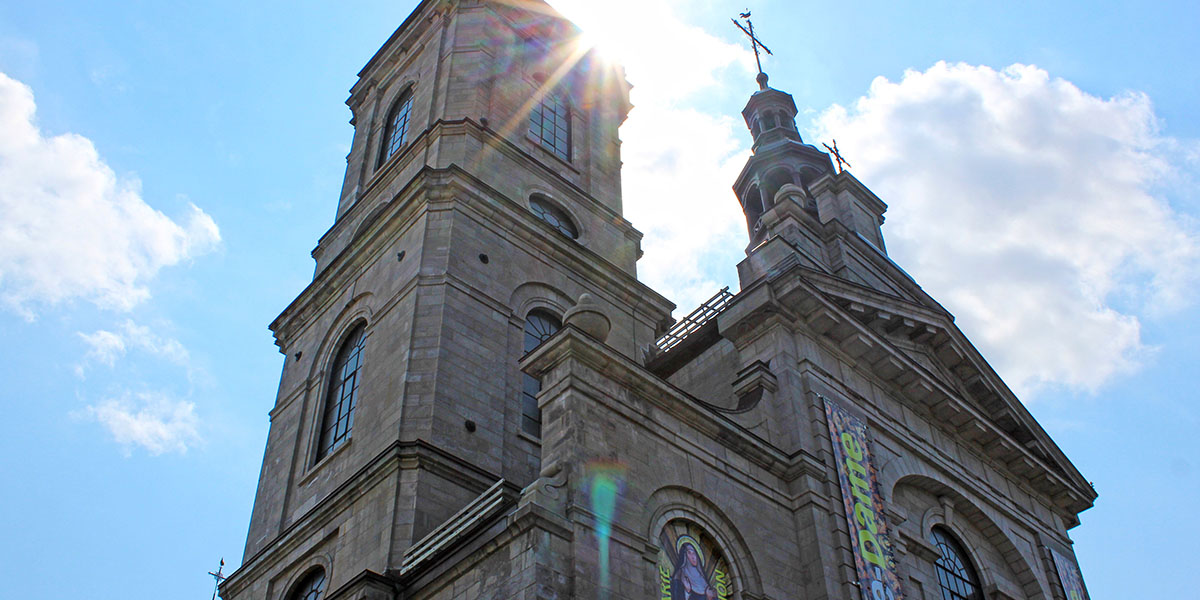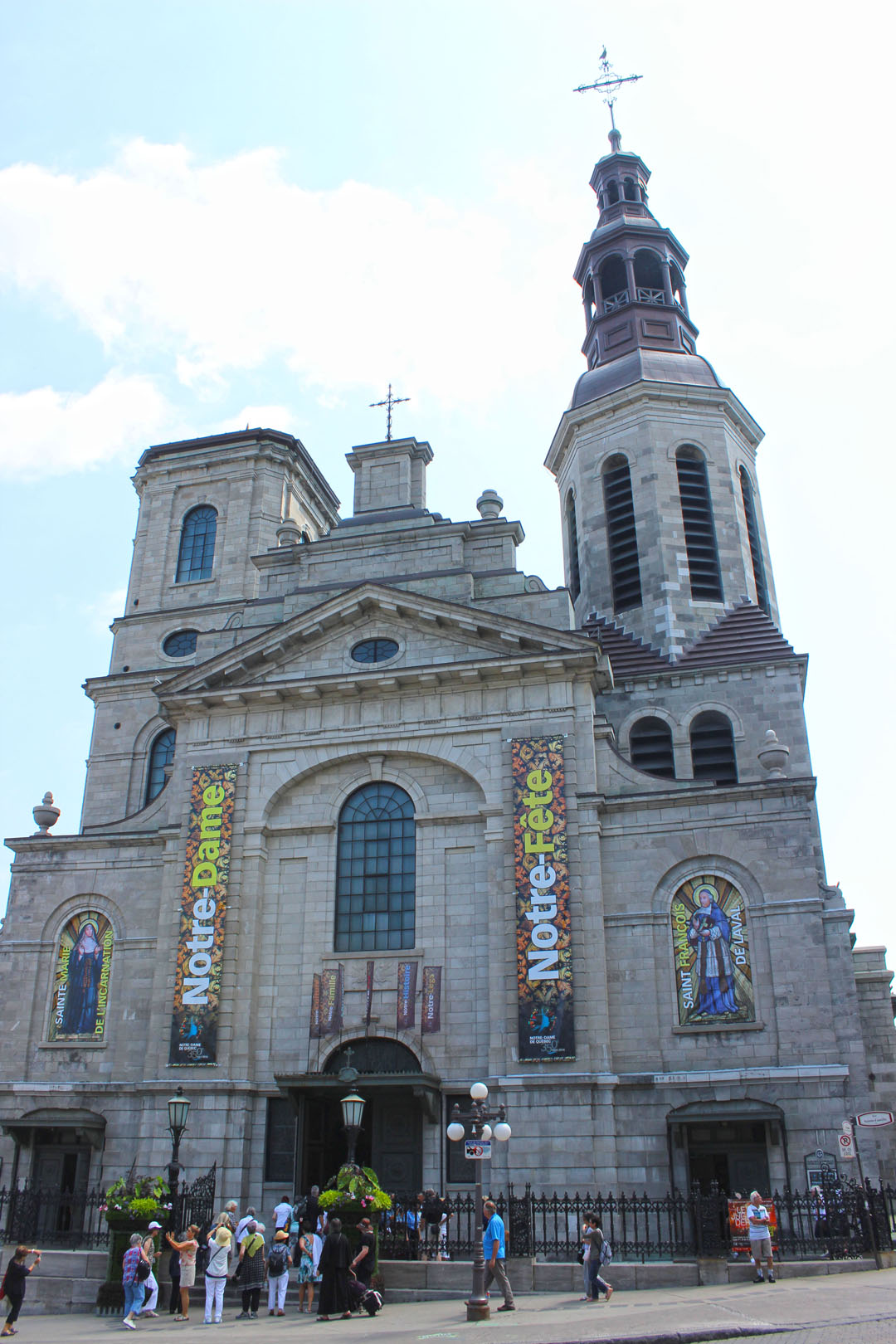
No matter what religion or faith you follow (or choose not to follow), religious buildings can be beautiful and historic places to visit when you travel. Notre-Dame de Quebec Basilica-Cathedral is one of these such places and it’s worthy of a spot on your Quebec City itinerary.
During our trip, the church celebrated its 350th anniversary. It’s the oldest of all parishes in North America, north of Mexico.

A Brief History of Notre Dame de Québec
The Cathedral was originally built in 1647, but it burned to the ground twice. The first time, in 1759, it was destroyed during the Siege of Quebec. It was re-built according to the original plans with an added belltower.


In 1922, the church was again completely ravaged by fire and had to be re-built. In 1989, it was designated as a National Historic Site of Canada.
The church is the final resting place of four governors of New France, and the bishops of the diocese of Québec, including François de Laval, Quebec’s first bishop.
The Interior of the Church


The interior decorations of the church are quite impressive. Designed in the Rococo style, the ceilings are extremely high and everything appears to be dripping in gold.




There are magnificent stained glass windows lining the outer walls. One of the most remarkable pieces inside the Cathedral is the Baldacchino, a brilliant golden sculpture over the altar at the front.
We enjoyed a few quiet moments here as we viewed the many statues and works of art.
Notre Dame de Quebec: The Holy Door


The Cathedral-Basilica Notre Dame de Quebec is celebrating a Jubilee as it turned 350 years old in 2014. A Jubilee can be described as a time for a new start or new outlook on life.
To celebrate the 350th anniversary of the Cathedral, a Holy Door was constructed at Notre Dame de Québec in 2013. People are able to cross through the door before it is sealed shut at the end of 2014.
However, it was reopened in 2015 through to the end of 2016 even though it was not a Jubilee year. Pope Francis declared that all Holy Doors around the world would open from December 2015 to November 2016 since 2015 was a difficult year. He determined that they would be opened for a year of mercy.
We really enjoyed our visit to the Cathedral-Basilica of Notre Dame de Québec. We didn’t take a guided tour through the church, although they were available. Instead, we walked through at our own pace.
It is really nice that admission to the church is free, so everyone can enjoy the stunning architecture and interior decorations. We didn’t find that it was a very crowded attraction either, and there was only a minimal wait in front of the Holy Door.
How to Visit the Holy Door


This holy door is the first one located outside of Europe. Here is a list of the Holy Doors around the world:
- Saint Peter’s Basilica in Vatican City
- Archbasilica of St. John Lateran in Rome
- Basilica of Saint Mary the Great in Rome
- Basilica of Saint Paul Outside the Walls in Rome
- Santa Maria di Collemaggio in L’Aquila
- Atri Cathedral in Atri
- Santiago de Compostela Cathedral in Galicia
- Pontifical University of Santo Tomas Chapel in Manila
- Sanctuary of the Curé of Ars in Ars-sur-Formans
- Notre-Dame Basilica-Cathedral in Quebec City
A Holy Door is a symbol of oneness with the Universal Church. It is also a symbol of convocation, an invitation to persons of good will to enter, whatever their religious denominations.


Crossing the Holy Door is a spiritual undertaking in which any person of goodwill can participate regardless of religion. Before passing through the door, I took the opportunity to reflect on my own journeys through life thus far, and contemplated the ways that I could be a better person, to myself, my loved ones, and within our society.
It was a unique experience being able to cross through a Holy Door. Even though I’m not religious in the slightest, I can see the positive aspects of this meditative ritual, the self-reflection, and wanting to transform your own life for the better.
The door must be crossed from the outside of the church to the inside. It is recommended that you spend a short period of time in the garden beside the church to meditate and reflect before crossing the Holy Door. The Holy Door is located beside the main entrance.
The Seminary of Quebec


At first, we didn’t really explore this area as we just didn’t notice it at first. One night, we were just walking around the church and we decided to stroll through a tunnel that took us to a central courtyard.
We thought it looked pretty neat, but we still really had no idea where we were. Not until we came home did we realize that we walked through the courtyard of the Séminaire de Québec.
The Roman Catholic priests in Quebec City reside here, and there are a vast number of historical buildings that are a part of the Seminary, built between the 17th and 20th centuries. The Vieux-Séminaire buildings were constructed in the image of 17th century French colleges and has a spectacular courtyard in the centre.






The Seminary was designated as a national historical site in 1929. It was a brisk summer night as we sauntered through the courtyard, marveling at the impressive structures all around us.
It was part of a lovely evening walk where we didn’t really know what we would stumble upon or where we would end up. Quebec City is an incredibly safe place to walk around at night.
While exploring during the daytime is best for attractions and sight-seeing, the city is quite beautiful at night and there weren’t many other people around, giving us the impression that we had the place mostly to yourselves.
I would highly recommend visiting both the Notre Dame de Quebec and walking through the courtyard of the Séminaire de Québec if you’re a fan of history and architecture. Located outside of the courtyard beside the Cathedral, the Musée de l’Amérique Francophone gives tours of the seminary grounds and the interior in summer.







